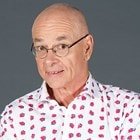The Fred Hollows Foundation’s Arclight

Dr Karl Kruszelnicki
Dr Karl Kruszelnicki

TODAY, MORE THAN 32 million people around the world are blind, while a further 190 million are visually impaired. There is a humanitarian and economic benefit in remedying this situation. For every $1 invested in ending avoidable blindness, a country’s economy gains $4. Fred Hollows, the late visionary Australian ophthalmologist, worked tirelessly to help remedy cataracts, with cheap intraocular lenses. These replace the damaged lens in the eye.
Let me give you a little anatomy lesson to explain more. The eye is a globe or ball about 25mm across. On the inside, at the back, is the retina, which is a layer about 0.3mm thick. It has cells that turn incoming light into electricity, which the brain turns into what we see. This light has to be focused and brought into a sharp image, and there are two ‘lenses’ that do this. The first, right at the front of the eye, is the curved structure called the cornea. It’s not adjustable. The second one, the intraocular lens, is adjustable. It can change its shape to keep either near or distant objects in sharp focus.
Both lenses should be transparent, but the intraocular lens can become cloudy with age, forming a cataract. One of Fred Hollows’ great achievements was to lower the cost of cataract surgery and to reduce the cost of the artificial intraocular replacement lens.
The Fred Hollows Foundation is involved with another innovation – the Arclight. It’s a cheap ophthalmoscope, a tool to clearly see the surface of the retina. Many serious conditions (such as cataracts, diabetic eye disease, papilloedema and macular degeneration) are best diagnosed with an ophthalmoscope. But they cost $300–800, which is big bucks for poor countries.
The Arclight ophthalmoscope is an effective and cheap alternative, costing as little as $10 a unit when bought in bulk. Other clever features make it perfect for the developing world, such as being solar powered and having long-life LEDs. Three to four hours of sunlight is enough to power 100 minutes of continuous use. It also has a built-in otoscope to examine ears, and a 4x magnifying lens. And there’s no compromise on quality! Studies show that it performs as well, and is easier to use, than a standard ophthalmoscope.
Fred’s vision for the future is illuminating.
Visit www.hollows.org for more information.




